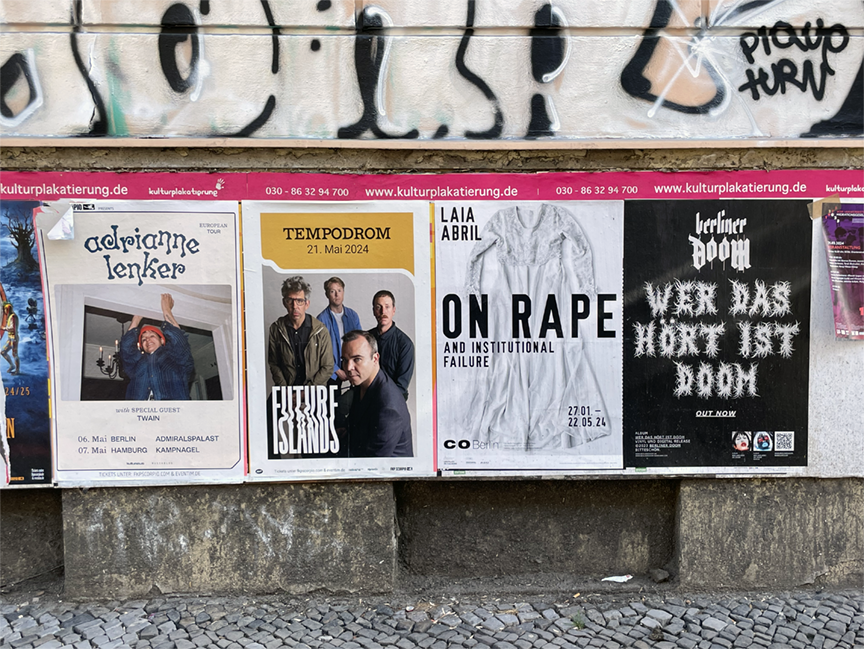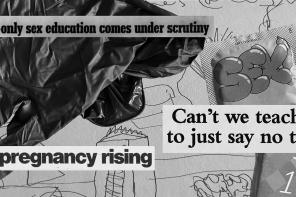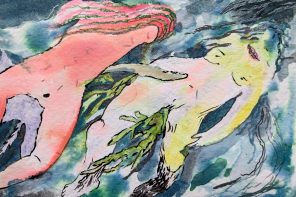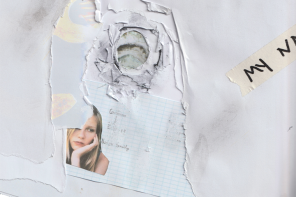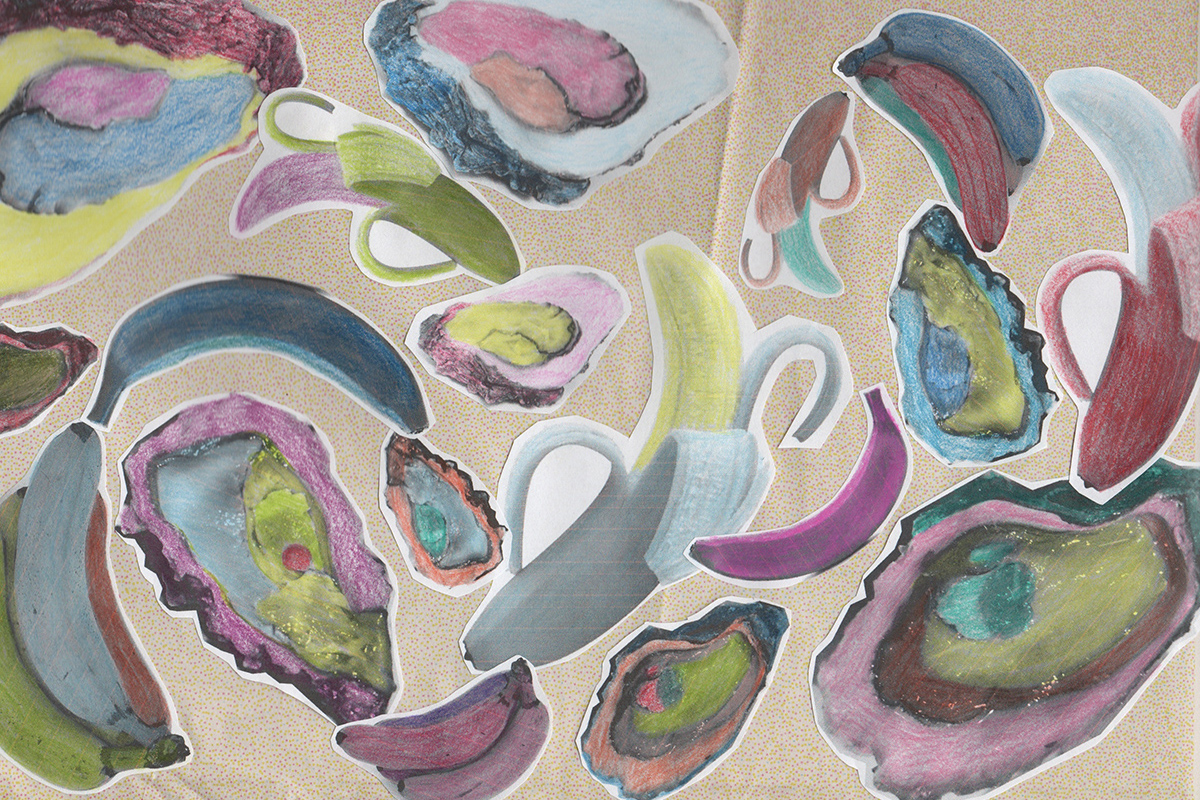Laia Abril’s On Rape – And Institutional Failure is a small exhibition packed with written information, occupying the front three rooms of the upstairs gallery space at C/O Berlin. The installation begins by tracing historical and current legal, cultural, and religious perspectives on rape, virginity, and the value of women; individual texts are paired with a black and white image of a thematically relevant object. The viewer then enters a room commanded by eight short, first person narratives (provided to Abril by participants), accompanied by singular life-size black and white images of clothing representing the institution within which the assault occurred: school, the military, religion, marriage, and so on. The final room contains a range of examples of the ubiquity of rape in the form of jokes, media, and analogues in popular culture, as well as a compilation of stills from rape revenge films like I Spit on Your Grave (both the 1978 and 2010 versions) and Promising Young Woman (2020), created by the artist.
The specific rapes referenced within the show are largely assaults involving multiple men, against cis women, implicitly or explicitly vaginal, under threat of or using extreme violence. To the extent that rape within intimate relationships is mentioned, the examples are limited to marriages where it is not clear that mutual feeling between the participants ever entered the picture, with such examples coming exclusively from the Global South. Throughout the exhibition, a series of quotes by predominantly US American politicians and lawyers accompany the viewer, among them 2012 Missouri US Senate candidate Todd Akin’s opinion on “legitimate rape” and former President Donald Trump’s bragging reference to grabbing women “by the pussy”. The personal narratives articulate pain and (much needed) nuance, but it is otherwise a jarring presentation of monstrous acts occurring around us in silence, begging the viewer to intervene. Near the middle point of the exhibition space, a large text confronts the viewer, asking whether they have ever had sex “without consent”, with someone who was drunk, or using some form of power over the other person.
This show is the second installment of Abril’s research project, A History of Misogyny: a collection of statistics, facts, artifacts, and images representing her own interrogation of the subject, rather than an all-encompassing scientific study. This is her perspective and summation of the systematic nature of rape the world over, presented meticulously in the format of an anthropological exhibit; a reclamation of a language of institutional knowledge. As a viewer, I felt the artist’s overwhelm with the scale of the problem palpably, and her fear, for herself, for other women, and for the moral state of the world and its institutions. Indeed, institutions produce, control, and regulate not just sexual violence and its ubiquity, but also what we understand sexual violence to be, who can experience it and how, and what should (or should not) be done about it. In this sense, On Rape – And Institutional Failure reinforces a series of dominant paradigms about sexual violence: that rape is committed by an Other, an Unknown (cis) Man or Men, to whom women are always and inherently, by their very nature, vulnerable.
At the most basic level, focusing on violent, public, highly sensationalized assaults involving strangers, like the one that sparked Abril’s interest in the topic, as representative of rape writ large is misleading – most people who are raped know the person who assaulted them. References to marital rape and having to marry one’s rapist within the exhibition mention the explicit and current legality of such practices in countries in West Asia and Africa, but fail to mention that, for example, marital rape was only criminalized in the USA in 1993 and in Germany in 1997. Fundamentalist religious communities of many stripes the world over also hold similar values and practices regarding extramarital sex and pregnancy to those cited, without differentiating according to desire or consent, and with or without the outright support of a national legal system. In contrast to the text confronting the viewer about whether they have personally raped someone, this dominant framing positions rape outside the context in which the exhibition is presented, both geographically and narratively. All of the examples Abril cites are real, legitimate, and devastating, but together, they paint a picture which slots cleanly into many people’s existing biases: sexual violence is horrifying, heartbreaking, and condemnable, but not something the viewer needs to personally reflect upon in a European context, as long as (implicitly) he is not prowling in a dark alley or club bathroom.
A victim receiving justice, as presented within the exhibition, seems to hinge on the length of the prison sentence meted out to a perpetrator in a courtroom. While it is difficult to get most legal systems to take even well-documented and prototypical cases of rape seriously, legal recourse is also a blunt instrument in this context. In the case of a violent rape by a stranger, the person who was raped might feel less complicated about engaging with the legal system (or even naming what occurred as rape) than, say, if the person who raped them is a friend, partner, or family member. Though a small number of texts involve some mention of a victim being retraumatized by a criminal proceeding, the idea that certain outcomes of involving the legal system might not be something a victim wants (anything from being scrutinized themselves by a deeply biased legal system, to detainment, deportation or other negative consequences for the rapist or their family, to continuing cycles of violence through a carceral prison system itself rife with sexual violence) are absent. These are thorny, ethically complex, and deeply painful realities, and to leave them out of an indictment of rape and its perpetuation through institutions is a loss.
What if Abril had, instead, used questions about how various religious, cultural, and legal traditions understand sex and cis women’s value to trace current understandings of sex, and a particular kind of sex, as an obligation and ideal within romantic relationships, reinforced by legal, medical, and cultural frameworks? How might these norms shape our ideas about how we can or should behave in relationships, or even what kind of relationships it is possible to have? How do we understand what a potential sexual partner owes us, or what we owe a partner, regardless of our health, physical or emotional capacity, or personal desires? How do we think of, value, and act on our own desires? How are we taught to feel about ourselves when we are rejected sexually? Are we encouraged to punish others for that feeling? To keep trying? To exert pressure? To blame ourselves or our partner? Is sexual assault necessarily less shattering when it doesn’t involve a penis in a vagina, as it is so often defined legally? Or does it merely not fit within a framework where concern about pregnancy, and therefore inheritance and property rights, are paramount?
Given that men hold the vast majority of institutional, cultural and interpersonal power positions worldwide, it is not surprising that the majority of sexual violence is enacted by men. Abril’s narrative, that rape is also a(n implicitly cis) men’s issue, is certainly true. However, confronting cis men with stories of violent rapes by faceless attackers in unfamiliar contexts is unlikely to make them consider, for example, whether ‘having sex’ with a reluctant partner they pressured into it was also a harmful choice on the same continuum. Likewise, the idea that cis women are not also capable of violence (belied by details of some of the personal narratives in the exhibition, but otherwise absent from the artist’s framing) leaves intact a gendered power dynamic where women are potential victims and men are potential monsters, without space for other genders or narratives. Gendered power dynamics are very real, but power is also contextual and situational, and women, as people, are capable of harming others. If our fates are settled and our gendered moral positions are secure, we don’t have to consider what we might do differently, or how we might be harming ourselves and others through the perpetuation of these norms in our day-to-day lives. We live in a violent, power-laden society that victimizes us and demands that we victimize others in order to regain our humanity. What are we going to do about it?
On Rape – And Institutional Failure is on view at C/O Gallery in Berlin until 22 May 2024.
Text and Header Image by Ki Niehaus
Ki Niehaus is a multimedia artist, writer, and creative technologist living in Berlin. She enjoys thinking, writing, and making art about power, relationships, gender, sexuality, and pain. She has been collaborating with Coven Berlin since 2014.

